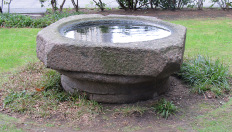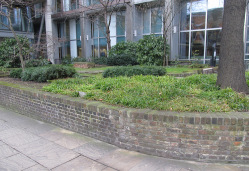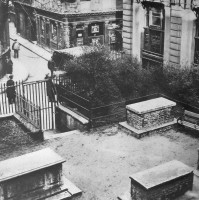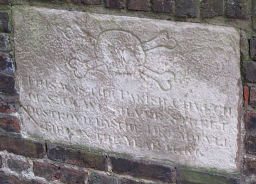Site of St Olave's Silver Street, London Wall
In the City of London, just off London Wall is the site of the Church of St Olave, Silver Street, a humble little garden next to modern buildings, with a few bits of wall. A worn stone plaque states: 'St Olave's Silver Street. This churchyard was thrown[?] back and the road widened eight feet by the Commissioners of sewers[?] at the request of the Vestry Anno Domini 1865. HJ Cummins Rector; FA Harris, CE Wilson Churchwardens'.
And opposite, a worn panel with skull and crossbones writes that 'This was the parish Church of St Olave Silver Street, Destroyed by the Dreadfull Fire in the year 1666' - see picture at bottom of page, click to enlarge. A guidebook states this panel is of late 17th Century date (ie put up soon after the Fire), not giving a source for this attribution, but certainly plausible. Skull and crossbones motifs were in use on monuments up into the mid-18th Century, an example on a headstone pictured on this website being at the bottom of the Hillingdon Church page.
The site of St Olave Silver Street.
The only monument is a single massive granite block holding water, rather like a Norman font, which may be the reworked remains of a pillar base or top (see top of page). Before the Second World War, there were at least a few ruinous chest tombs (picture below), in what was then 'a genuine piece of Shakespearean London', for this is the view Shakespeare would have had when he lodged in Silver Street with the Huguenot Christopher Mountjoy - though the particular chest tombs in the picture would be 18th Century or later.
St Olave Churchyard before the war.
The Church was dedicated, like several others (see page to St Olave Hart Street on this site), to St Olaf of Norway, and in later times was linked with the City Silversmiths and Goldsmiths, many of whom lived nearby. We know that in the 14th Century it had a chantry, or at least a bequest was made for its maintenance. The historian John Stow, visiting around 1600, recorded simply: 'Then at the North end of Noble streete, is the parrish church of S. Olave in Silver streete, a small thing, and without any noteworthy monuments.' It did at least have a bell, as did the replacement church erected in 1609. But the parish was very small, and the new church was not replaced when destroyed in the Fire of London. It seems remarkable that the site survives.
Commemorative panel with skull and crossbones.
Visits to this page from 13 Mar 2014: 6,039



